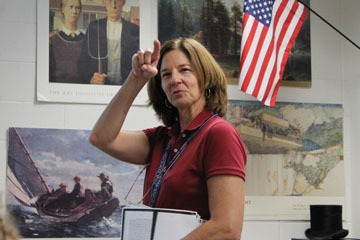College Board made changes to the AP US History and AP Computer Science A courses for the 2014-2015 school year and plans to administer the new tests next spring. According to College Board, the AP US History was completely redesigned and a new lab requirement was added to AP Computer Science A.
The new lab requirement replaced the GridWorld case study with a lab component consisting of at least of 20 hours of hands-on lab experiences, according to College Board. However, the 2015 AP Computer Science A Exam will not incorporate questions that focus on the new labs and will continue to test students on concepts outlined in the course description. In addition, all questions related to the GridWorld case study will no longer be included on the exam.
Concerning the AP US History changes, AP US History teacher John Hebert said via email, “There is a complete overhaul of the curriculum in terms of what is being taught and how the students are being tested. Teachers have more freedom in what and how they teach but students will be tested in more predictable ways. I think what students can expect on the exam in May is a test that covers the standards but gives them the ability to draw more comparisons and support claims with information of their choosing.”
Junior Kimaya Raje, who is currently enrolled in AP US History, says she thinks the new curriculum will be similar in difficulty to the old curriculum, however, different skills will be stressed.
Raje said via email, “I think the course will be similar to years past in difficulty as less memorization is nice, but we will be tested on skills that we may not have developed as well since they were not previously stressed. I prefer the old (curriculum) because memorization is based upon studying well. For the new method, you may be prepared, but if you haven’t developed the necessary skills, you may not succeed.”
AP US History teacher Karen Taff, however, disagrees with Raje in terms of whether or not the redesigned curriculum will be better than the old one.
Taff said, “I honestly think that the test is going to be (a) much better test because it’s going to test depth as well as breadth. Now, we are being intentionally focused on making sure that we cover historical themes, as well as checking to make sure that the kids can demonstrate the skills, whether it’s argumentation or identifying cause and effect, or using historical evidence. All those things we’ve always done, but now the tests are really going to be more specific to making sure the students can do that.”

According to College Board, while the old test included 80 multiple-choice questions, one document-based question and two free-response questions, the new exam has only 55 multiple-choice questions, one document-based question, four short answer questions and one long-essay question. The main goal of reducing the number of multiple choice questions was to better assess thematic understanding and application of historical thinking skills, as Taff said.
In addition, Hebert said rather than the multiple-choice questions being driven by simple facts, a source is provided and students are required to interpret it.
Because of the change in curriculum for AP US History, Raje and Taff both agree that students will have to find different ways to study than in previous years due to the fact that College Board has not released any practice tests. According to Taff, some of these ways include using materials given in class and practicing with tests throughout the year.
Taff said, “We’ll get lots of practice in class with the activities that we do and, of course, the tests we take throughout the year, I’m working really hard to try to model the way we test and how we assess the test consistently with what’s on the website and what I learned at the AP Summer Institute at Louisville.”
In addition, both Hebert and Taff said they are not worried about students’ scores dropping as a result of it being the first year of the new exam.
Taff said, “Typically, nationally, whenever the test is changed, scores drop. I don’t know what will happen but our students have always done better anyway than the national statistics, so we’ll just do the best we can.”
However, despite the potential score drop, Taff said the redesigned test is still an improvement from the old one.
“Based upon my work with professors at (Indiana University), the new AP test is more in line with what’s going on at the university level, rather than the old test which was really a trivial pursuit in some ways,” Taff said. “This is the better test.”




























![Keep the New Gloves: Fighter Safety Is Non-Negotiable [opinion]](https://hilite.org/wp-content/uploads/2024/12/ufcglovescolumncover-1200x471.png)
















































![Review: “We Live in Time” leaves you wanting more [MUSE]](https://hilite.org/wp-content/uploads/2024/12/IMG_6358.jpg)
![Review: The premise of "Culinary Class Wars" is refreshingly unique and deserving of more attention [MUSE]](https://hilite.org/wp-content/uploads/2024/12/MUSE-class-wars-cover-2.png)
![Introducing: "The Muses Who Stole Christmas," a collection of reviews for you to follow through winter [MUSE]](https://hilite.org/wp-content/uploads/2024/12/winter-muse-4.gif)
![Review: "Meet Me Next Christmas" is a cheesy and predictable watch, but it was worth every minute [MUSE]](https://hilite.org/wp-content/uploads/2024/11/AAAAQVfRG2gwEuLhXTGm3856HuX2MTNs31Ok7fGgIVCoZbyeugVs1F4DZs-DgP0XadTDrnXHlbQo4DerjRXand9H1JKPM06cENmLl2RsINud2DMqIHzpXFS2n4zOkL3dr5m5i0nIVb3Cu3ataT_W2zGeDAJNd_E-1200x884.jpg)
![Review: "Gilmore Girls", the perfect fall show [MUSE]](https://hilite.org/wp-content/uploads/2024/11/gilmore-girls.png)
![Review in Print: Maripaz Villar brings a delightfully unique style to the world of WEBTOON [MUSE]](https://hilite.org/wp-content/uploads/2023/12/maripazcover-1200x960.jpg)
![Review: “The Sword of Kaigen” is a masterpiece [MUSE]](https://hilite.org/wp-content/uploads/2023/11/Screenshot-2023-11-26-201051.png)
![Review: Gateron Oil Kings, great linear switches, okay price [MUSE]](https://hilite.org/wp-content/uploads/2023/11/Screenshot-2023-11-26-200553.png)
![Review: “A Haunting in Venice” is a significant improvement from other Agatha Christie adaptations [MUSE]](https://hilite.org/wp-content/uploads/2023/11/e7ee2938a6d422669771bce6d8088521.jpg)
![Review: A Thanksgiving story from elementary school, still just as interesting [MUSE]](https://hilite.org/wp-content/uploads/2023/11/Screenshot-2023-11-26-195514-987x1200.png)
![Review: "When I Fly Towards You", cute, uplifting youth drama [MUSE]](https://hilite.org/wp-content/uploads/2023/09/When-I-Fly-Towards-You-Chinese-drama.png)
![Postcards from Muse: Hawaii Travel Diary [MUSE]](https://hilite.org/wp-content/uploads/2023/09/My-project-1-1200x1200.jpg)
![Review: "Ladybug & Cat Noir: The Movie," departure from original show [MUSE]](https://hilite.org/wp-content/uploads/2023/09/Ladybug__Cat_Noir_-_The_Movie_poster.jpg)
![Review in Print: "Hidden Love" is the cute, uplifting drama everyone needs [MUSE]](https://hilite.org/wp-content/uploads/2023/09/hiddenlovecover-e1693597208225-1030x1200.png)
![Review in Print: "Heartstopper" is the heartwarming queer romance we all need [MUSE]](https://hilite.org/wp-content/uploads/2023/08/museheartstoppercover-1200x654.png)




